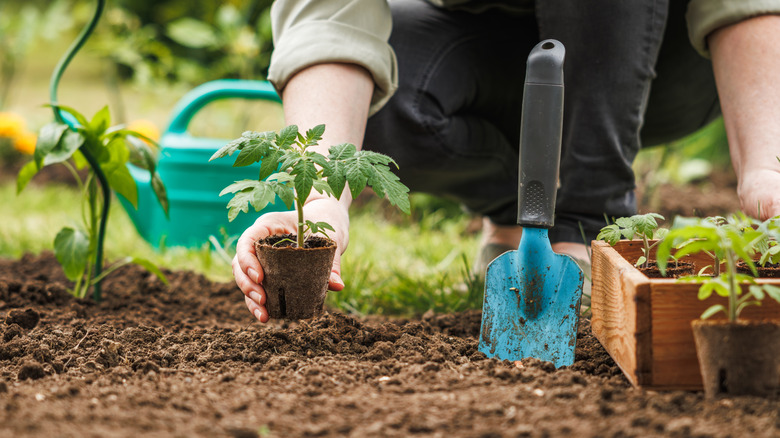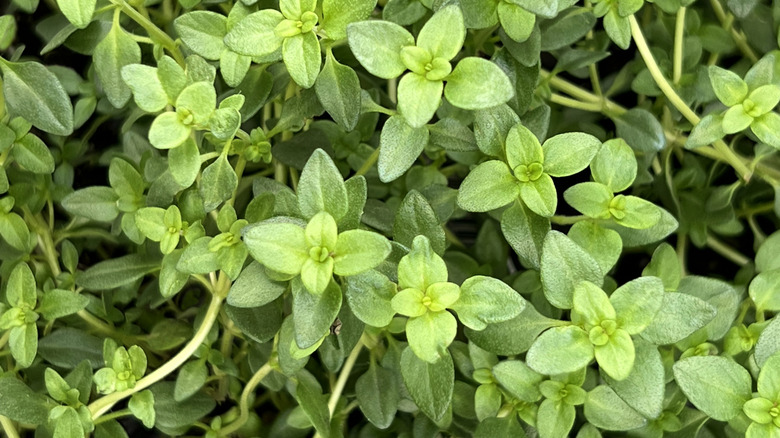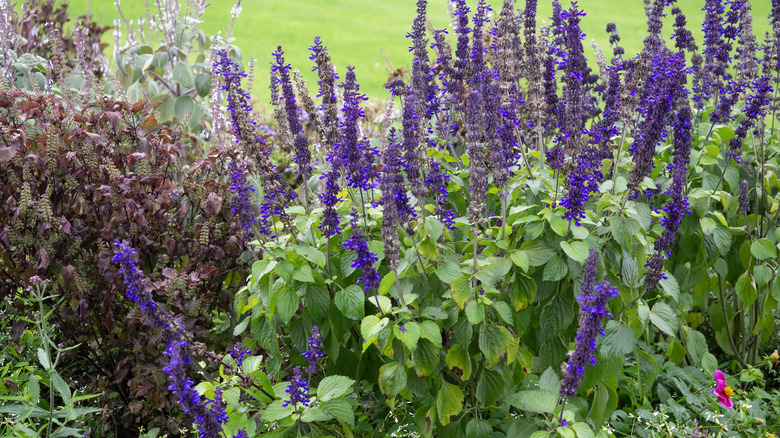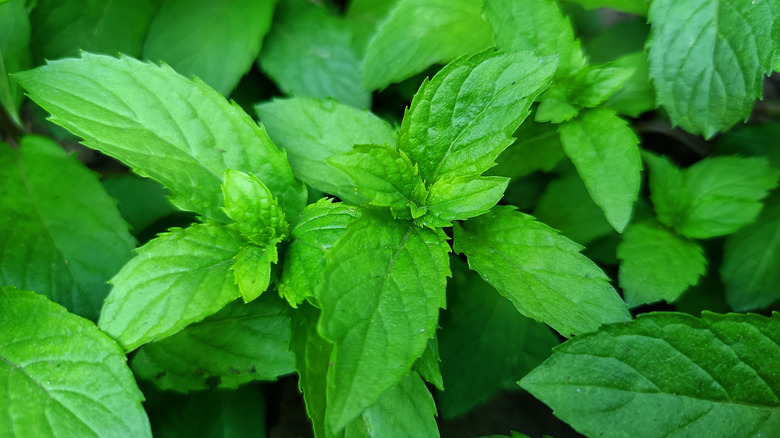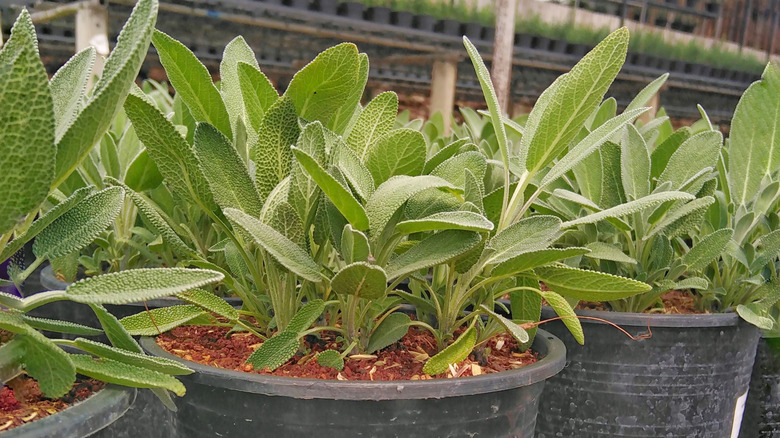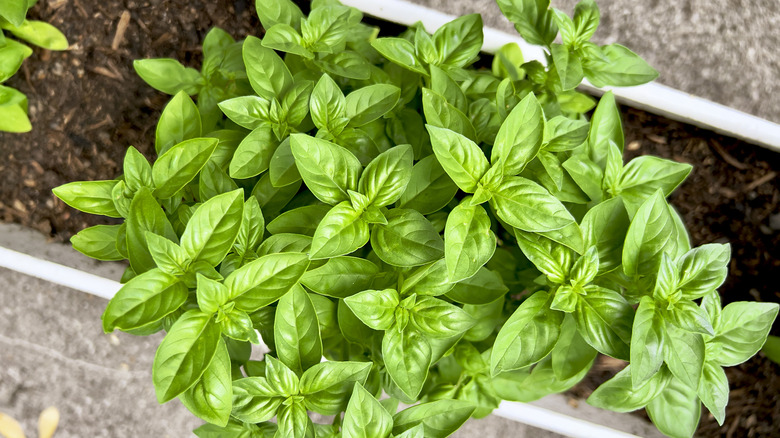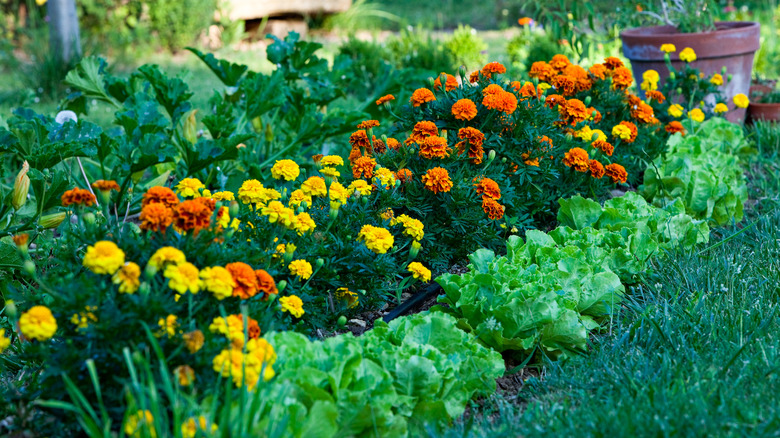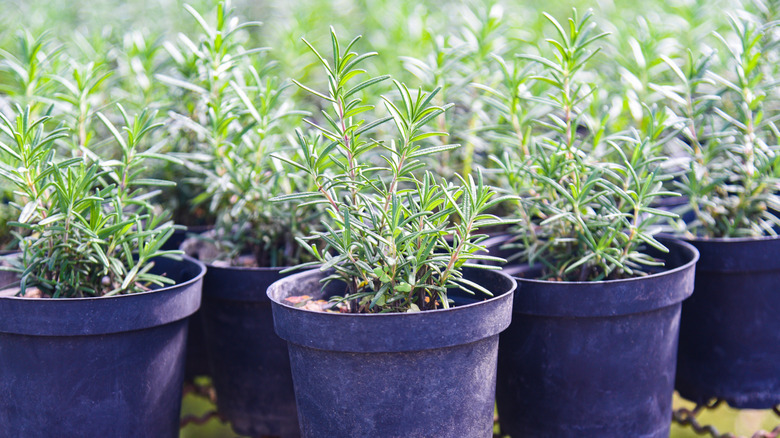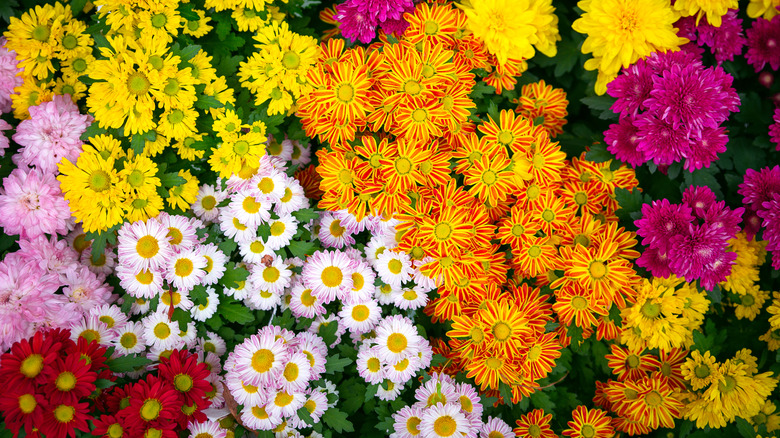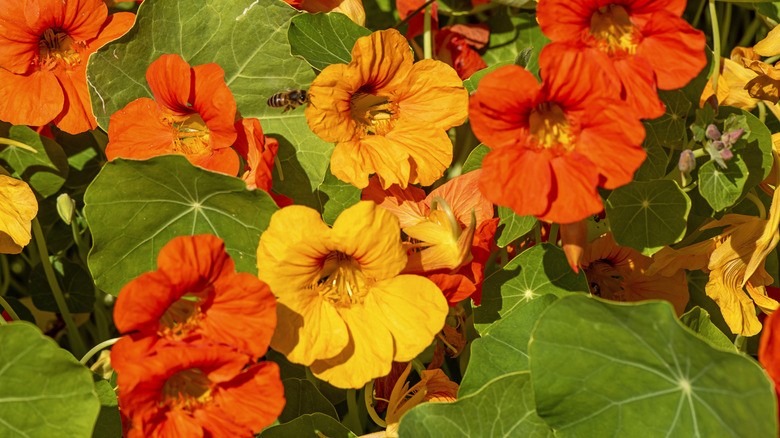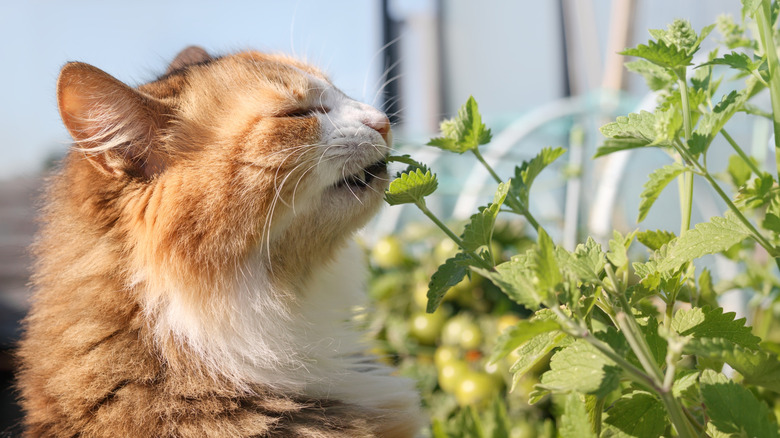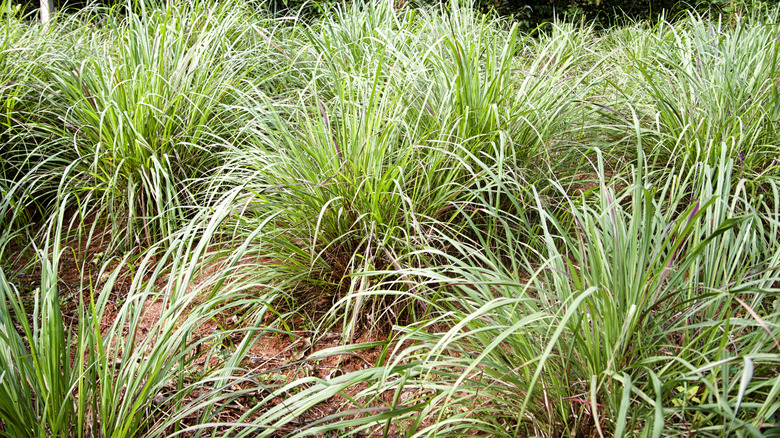11 Flowers & Herbs That Can Help Keep Pests Out Of The Garden
When starting and maintaining a garden, it can feel like your hard work is at the mercy of the elements. One major factor that can impact your flowers, herbs, and veggies is, of course, the presence of pests. Insects are probably the first thing that comes to mind in that regard, but other pests — such as rodents, deer, and more — can also cause havoc when they find something tasty in your garden. This is where strategically planting pest-deterring flowers and herbs could help.
While not 100% foolproof against all pests, it may be beneficial to use specific flowers and herbs. It may be especially effective in a companion planting strategy, which consists of purposely planting certain items that may offer protection close by (tomato and basil are one example of this). Additionally, using other plants to repel pests may be preferable to spending money on chemical-based insecticides that may harm both you and beneficial pollinators. So, if you're thinking about repelling pests more naturally, there are multiple herbs and flowers to consider, and some of these can also be kept in planters that you can place strategically around your garden or near entryways to your home. These all work against specific pests, and they have different benefits and caveats to keep in mind.
Lemon thyme is a durable plant that can deter a variety of pests
Thyme is a multipurpose herb that often evokes a blend of citrusy or floral scents. Lemon thyme (Thymus citriodorus), in particular, emits a natural citrus scent that many gardeners love. It just so happens that the lemon scent of the leaves turn off a variety of insects. For these reasons, you might consider planting lemon thyme to help deter roaches, mosquitoes, flies, and even termites. As a bonus, the leaves of lemon thyme are edible, and the plant itself is known for being resistant to other pests, such as deer and rabbits, as well as diseases.
To grow lemon thyme, know that this plant does best in partial sun and well-draining soils, though it can adapt to other spots in your garden, too. Each plant can also grow up to a foot tall if left unpruned. To help manage this, you may consider growing lemon thyme in containers. As a pest deterrent, consider placing lemon thyme strategically around other plants or flowers that may be invaded by insects, deer, or rabbits. In theory, the scent may help turn off would-be pests. If lemon thyme is allowed to flower, the resulting pink blooms can help support pollinating species that feed on the resulting nectar.
Lavender may ward off flying insects
In essential oil form, lavender (Lavandula) can be a useful item to have on hand in your home for a variety of purposes, including wounds and aromatherapy. Yet the benefits of this purple flowering plant can go beyond possible medicinal uses. Your garden is one such possibility. If you're having problems with flying insects, such as flies, moths, and mosquitoes, it turns out that growing lavender plants could offer an effective remedy. As a bonus, while its scent turns off such insect invaders, humans tend to find it quite soothing.
If you live in a warm and dry climate with naturally rocky soil, you may find it relatively easy to grow lavender. It's also best to transplant young lavender plants you might purchase from a greenhouse or garden shop in an area with full sun. You'll also want to make sure you space each plant at least 2 feet apart from one another to allow them to grow without crowding out other plants nearby. However, before you start planting lavender, be aware that the plant can be toxic to cats, dogs, and horses. Use caution if you have any of these types of pets.
Repel pests with the strong scent of mint plants
There are over 600 species of mint plants (Mentha spp), each with different characteristics, scents, and tastes. But all mint plants may share one major component in common: They contain menthol, which is often touted as a repellent for numerous types of pests, including insects and rodents. You also have different options to choose from, including peppermint, chocolate mint, and spearmint, all of which may have varying menthol levels.
When considering how to grow mint, it may be best to grow these in containers. One major caveat is the invasive nature of mint, as it can take over a garden rather quickly without frequent pruning. Another consideration is placement of this herb. While you can plant in pots throughout your garden, you might want to place them to help prevent insects and rodents from eating other items. In particular, peppermint can make a good companion plant for members of the cabbage family, including broccoli, cauliflower, and kale.
Sage may help repel mosquitoes in your garden
As a member of the mint family, sage (Salvia officinalis) is an aromatic plant that can be used in cooking. Sage is also one of many plants whose leaves are thought to help repel mosquitoes. Aside from the plant alone, some people may even rub sage leaves on their skin as a natural alternative to commercial mosquito repellants. Sage can be a welcome addition to your garden thanks to its earthy-scented leaves, while also being a turn-off for mosquitoes that may otherwise hang out among other plants or pester you and your loved ones. As a bonus, its lavender-colored flowers that bloom in the summer months may help support pollinators such as hummingbirds and butterflies.
If you're looking to incorporate and grow sage in your garden, know that this herb requires well-draining soil as well as full sun. Like mint plants, sage can grow out of control without regular pruning, so you may want to consider planting them in pots throughout your outdoor spaces to help control mosquitoes. If you do plant them directly in the ground, be aware that each sage plant can grow over two feet tall if you don't maintain them. They also do best when spaced two feet apart from each other.
Basil can be a deterrent for many flying insects
Arguably one of the most commonly used herbs in kitchens, basil (Ocimum basilicum) can have other uses besides cooking. Like sage, basil is a member of the mint family, and it also has strong-scented leaves that humans can appreciate, but certain pests do not. In particular, basil may be an effective deterrent against mosquitoes and flies in your garden. It's thought that these pests do not like the strong scents of the leaves. The aroma may be enhanced even more when the leaves are slightly bruised.
To plant basil as a flying insect deterrent, you may also consider ways to place it to help other plants you might have in your garden. For example, basil is considered a good companion for asparagus and tomato plants. Full sunlight and moist soil are other important factors when considering basil plant care and maintenance, and you should space them two feet apart to give each plant plenty of room to grow. Also, if you are adding basil to help combat pests, you may consider going easy on pruning these pants. According to a 2022 study of basil's efficacy against aphids in greenhouses suggests that the plant is most effective when planted in high density and in conjunction with other pest control methods.
Marigolds may repel pests both big and small
While a variety of garden plants may help repel pests, your option can go beyond herbs. Marigolds (Tagetes) are just one example. There are at least 50 known species of these beautiful flowers, which tend to come in bright orange and yellow colors. Aside from their colors and ability to attract pollinating species to your garden, there's also a possibility they can repel a variety of insect pests because of their strong citrus-like scent. There's also some evidence the roots of the plant may repel nematodes.
While some research is mixed on the efficacy of marigolds against garden plants, the general consensus appears to be that using them as companion plants may be worthwhile in helping to protect vegetable gardens. Among these include eggplant and squash. If you're wanting to grow marigolds, know that these plants may reach one to four feet tall, and they need full sun. For companion planting, you'll want to start with marigolds before vegetables and herbs, so the strong-scented flowers have a chance to bloom and potentially help protect other items in your garden.
Rosemary may repel a variety of insects
Like basil, sage, and lemon thyme, rosemary (Rosemarinus officinalis) is a fragrant herb that humans appreciate in their gardens, but certain pests may be averse to. In particular, this herb is thought to help ward off insects, such as mosquitoes, fruit flies, and moths. In fact, rosemary oil is a known natural insect repellent, and is sometimes combined with other oils, such as cinnamon, clove, thyme, and wintergreen. Research also suggests that you may be able to use rosemary to help repel insects in your garden to help protect other plants, such as sweet pepper.
Rosemary is technically an evergreen shrub, and it is related to the mint family. As such, you can expect it to grow large if it's not regularly pruned. In some areas, rosemary can grow up to 6 feet tall. If you're growing rosemary, it's best to plant it in an area that gets full sun, and also to make sure you avoid overwatering their soil. Consider keeping rosemary in planters that you can transfer indoors before it's damaged by frost. This is also a good way to keep rosemary from growing too tall.
Colorful chrysanthemum flowers can repel certain insects
Nicknamed "mums," chrysanthemums (Chrysanthemum x morifolium) are colorful flowers that make beautiful additions to any garden. Aside from their aesthetic appeal though, chrysanthemums can offer more practical purposes such as their ability to repel insects. These flowers contain pyrethrins, which are compounds that are thought help repel ants, flies, mosquitoes, and other insects. When you plant mums in your garden, you may be able to help keep some of these pests away from other plants.
Chrysanthemums are known for blooming in the autumn months, and they can be placed in planters throughout your garden or yard for colorful pest-repelling effect. When caring for mums, you should place them in areas of partial to full shade, and to make sure they are kept moist without overwatering them. Potted mums generally need more water than those planted directly into the ground. It's also important to know that pyrethrins can be toxic to humans and animals, but serious cases are usually attributed to pyrethrin-containing chemical products, such as commercial foggers or head lice products. Some people do, however, experience skin irritation after touching mums. To err on the side of caution, keep children and pets away from these plants.
Nasturtiums benefit garden pollinators while repelling pests
Other flowers that can add both color and pest protection to your garden are nasturtiums (Nasturtium—Tropaeolum spp.). The flowers come in a variety of colors, making them attractive centerpieces in planters, or as companion plants to help protect vegetables in your garden. As a bonus, pollinating species, such as hummingbirds and butterflies, can eat nectar from nasturtiums. These flowers may also help prevent beetles and aphids when planted alongside other plants, such as those of the cabbage family, as well as celery.
When growing nasturtiums, know that you have a lot of options, including planters, baskets, and even placing seeds directly into the ground. Be aware that nasturtiums grow quickly, emerging from seeds within 10 days. Some are also trailing varieties, which can work well in baskets and against trellises. If you're looking to keep pests away from other garden plants, however, you may consider bush nasturtium varieties, which tend to grow more compactly without vines.
Catnip can keep both your garden and your cats happy
If you have a cat, chances are you have given your fur-baby catnip or catnip-containing toys from time to time. It turns out that catnip can do more than provide euphoria and contentment to cats. When considering your garden, catnip (Nepeta cataria) plants (not the dried version at pet stores) may help repel certain insects. As published in a 2021 issue of Current Biology, research shows that catnip may help repel and deter mosquitoes and flies. It may even be just as effective as commercial insect repellents, though researchers aren't quite sure exactly how catnip does this. It's possible that insects don't appreciate the strong scent of the plant.
Catnip is yet another member of the mint family that grows relatively well without much care. In fact, the weedy plant can easily grow three feet tall, and can flower for a couple of months at a time between spring and fall. To grow well, catnip primarily needs full sun and well-draining soil. Also, be aware that catnip leaves will likely attract cats, so you may need to try to keep your feline friends away from new plants to allow them a chance to grow.
Lemongrass adds character to your garden while deterring insects
Lemongrass (Cymbopogon citratus) is perhaps not planted as often as other herbs on this list. However, this plant has a unique weedy quality that can add some character to your garden. More importantly, the lemony scent may ward off pests, such as flies, mosquitoes, and roaches. Research suggests that the oil of lemongrass may act as a natural pesticide, and while it's not confirmed that these qualities translate to the plant, it's worth a shot. Interestingly, it's thought that dogs and cats also dislike lemongrass oil, which might make lemongrass plants helpful in deterring pets from your garden, as well.
It's relatively easy to grow lemongrass in your garden. The key is to plant lemongrass directly in an area that gets full sun, and to also make sure the plant gets plenty of water. Also, since lemongrass is native to tropical climates, this plant grows particularly well in regions with high humidity. If lemongrass is planted directly into the ground, you may need to hand weed in order to prevent weeds from taking over this citrus-scented plant.
